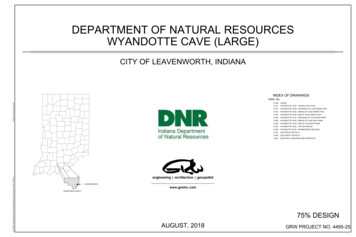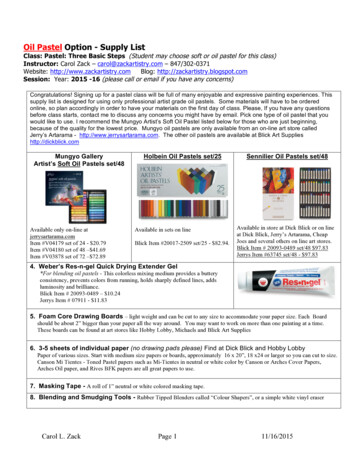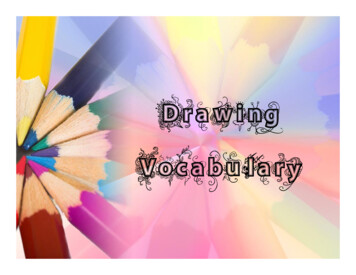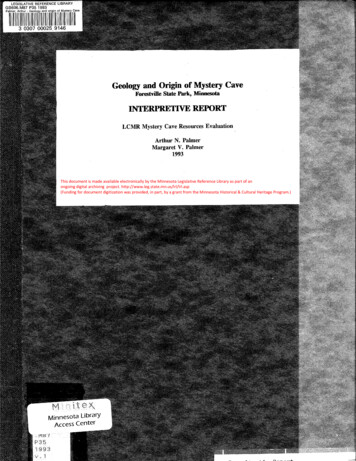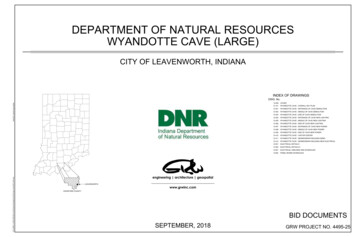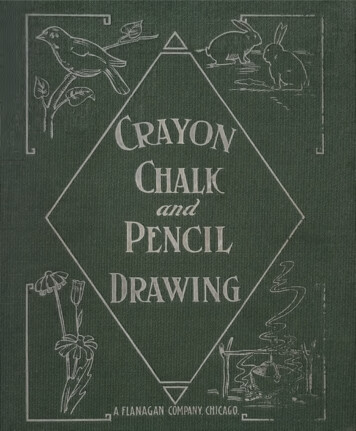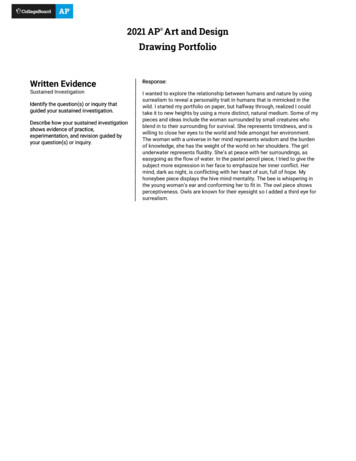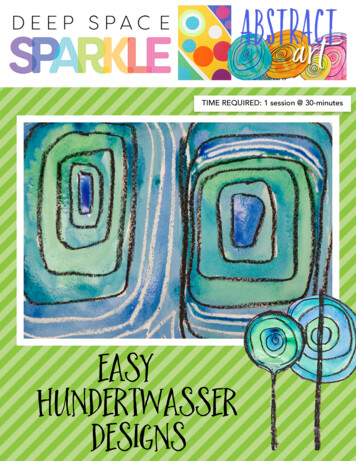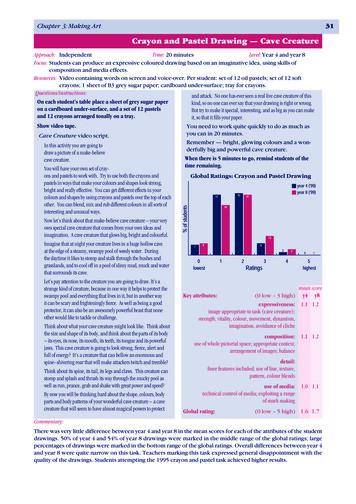
Transcription
Chapter 3: Making Art31Crayon and Pastel Drawing — Cave CreatureApproach: IndependentTime: 20 minutesLevel: Year 4 and year 8Focus: Students can produce an expressive coloured drawing based on an imaginative idea, using skills ofcomposition and media effects.Resources: Video containing words on screen and voice-over. Per student: set of 12 oil pastels; set of 12 softcrayons; 1 sheet of B3 grey sugar paper; cardboard under-surface; tray for crayons.Questions/instructions:and attack. No one has ever seen a real live cave creature of thisOn each student’s table place a sheet of grey sugar paperkind, so no one can ever say that your drawing is right or wrong.on a cardboard under-surface, and a set of 12 pastelsBut try to make it special, interesting, and as big as you can makeand 12 crayons arranged tonally on a tray.it, so that it fills your paper.Show video tape.You need to work quite quickly to do as much asyoucan in 20 minutes.Cave Creature video script.Remember — bright, glowing colours and a wonIn this activity you are going toderfully big and powerful cave creature.draw a picture of a make-believeWhenthere is 5 minutes to go, remind students of thecave creature.time remaining.You will have your own set of crayons and pastels to work with. Try to use both the crayons andGlobal Ratings: Crayon and Pastel Drawingpastels in ways that make your colours and shapes look strong,bright and really effective. You can get different effects in yourcolours and shapes by using crayons and pastels over the top of eachother. You can blend, mix and rub different colours in all sorts ofinteresting and unusual ways.Now let’s think about that make-believe cave creature – your veryown special cave creature that comes from your own ideas andimagination. A cave creature that glows big, bright and colourful.Imagine that at night your creature lives in a huge hollow caveat the edge of a steamy, swampy pool of weedy water. Duringthe daytime it likes to stomp and stalk through the bushes andgrasslands, and to cool off in a pool of slimy mud, muck and waterthat surrounds its cave.Let’s pay attention to the creature you are going to draw. It’s amean scorestrange kind of creature, because in one way it helps to protect theKey attributes:(0 low – 3 high) y4 y8swampy pool and everything that lives in it, but in another wayit can be scary and frighteningly fierce. As well as being a goodexpressiveness: 1.1 1.2protector, it can also be an awesomely powerful beast that noneimage appropriate to task (cave creature);other would like to tackle or challenge.strength, vitality, colour, movement, dynamism,imagination, avoidance of clicheThink about what your cave creature might look like. Think aboutthe size and shape of its body, and think about the parts of its bodycomposition: 1.1 1.2– its eyes, its nose, its mouth, its teeth, its tongue and its powerfuluse of whole pictorial space; appropriate context;jaws. This cave creature is going to look strong, fierce, alert andarrangement of images; balancefull of energy? It’s a creature that can bellow an enormous anddetail:spine–shivering roar that will make attackers twitch and ink about its spine, its tail, its legs and claws. This creature canpattern, colour blendsstomp and splash and thrash its way through the mucky pool aswell as run, prance, grab and shake with great power and speed?use of media: 1.0 1.1technical control of media; exploiting a rangeBy now you will be thinking hard about the shape, colours, bodyof mark makingparts and body patterns of your wonderful cave creature – a cavecreature that will seem to have almost magical powers to protectGlobal rating:(0 low – 5 high) 1.6 1.7Commentary:There was very little difference between year 4 and year 8 in the mean scores for each of the attributes of the studentdrawings. 50% of year 4 and 54% of year 8 drawings were marked in the middle range of the global ratings; largepercentages of drawings were marked in the bottom range of the global ratings. Overall differences between year 4and year 8 were quite narrow on this task. Teachers marking this task expressed general disappointment with thequality of the drawings. Students attempting the 1995 crayon and pastel task achieved higher results.
32NEMP Report 14: Art 1999MID RANGE EXEMPLARSThis work is characterised by bold filling of the page and strongly appliedpastel. The duck billed creature mayowe much to “Australiana” in its choiceof colouring and pattern. The confidentheavy black outline tends to flatten thedesign. Although no attempt has beenmade to give the swampy context, thecreature’s form seems well adapted tothat environment. The way it movesaround the page is assured.The body is boldly patterned andstrongly decorative. In contrast to thebody, the head feels a little pale andinsipid, lacking the strong colour anddefined features of the rest of the creature. This lack of continuity tends tofragment the reading of the image asa whole. The suggested movement inthe tail probably arises from the needto fill the space on the paper ratherthan any intention to suggest drama.There are no indications of the contextwhere this creature lives. Colours areused very discretely with no attempt toblend.
Chapter 3: Making Art33A ferocious evil grin has nasty pointyteeth and crossed bloodshot eyes. Thepastel is energetically scribbled togive a damp furry appearance. Mainfeatures are emphatically outlined incontrast to the soft body. While understanding contrast and depicting somestereotypical fierceness, the drawinglacks development of either form orcontext. Children exposed to manyyears of drawing “monsters” will oftenresort to their previous schema without elaboration. This could indicatefailure of the task to inspire new challenges as much as any apparent limitations in the drawing itself.The bold graduated colour on the tailsuggests the potential power of thisstudent’s work. However, much of theremainder of the drawing is filled withsmall linear patterns. In terms of overall design the creature has a pitbull likeferocious head with spiky ornamentation. Given more time to developboth the form and context this creature might become boldly original andvibrantly alive.One of the many “bug-eyed spotty monsters” this task inspired! Imaginativetasks can generate these kinds of solutions when there are no opportunitiesfor directed observation of actual creatures in motion. There is conscious useof bold colour patterning as well asmixed colour in the paler areas whichcould be either wings or background.The drawing appears to be growingfrom the centre outwards while remaining strictly frontal in pose. A developedbackground would enhance the potential drama. The limbs are “sausage-like”and non-threatening in their formlessness.
34NEMP Report 14: Art 1999LOW RANGE EXEMPLARS
Chapter 3: Making Art35HIGH RANGE EXEMPLARS
Crayon and Pastel Drawing — Cave Creature Independent Time: 20 minutes Year 4 and year 8 Students can produce an expressive coloured drawing based on an imaginative idea, using skills of . own special cave creature that comes from your own ideas and imagination. A cave creature that glows big, bright and colourful.
